Herb Gardens: How to Grow Your Own at Home
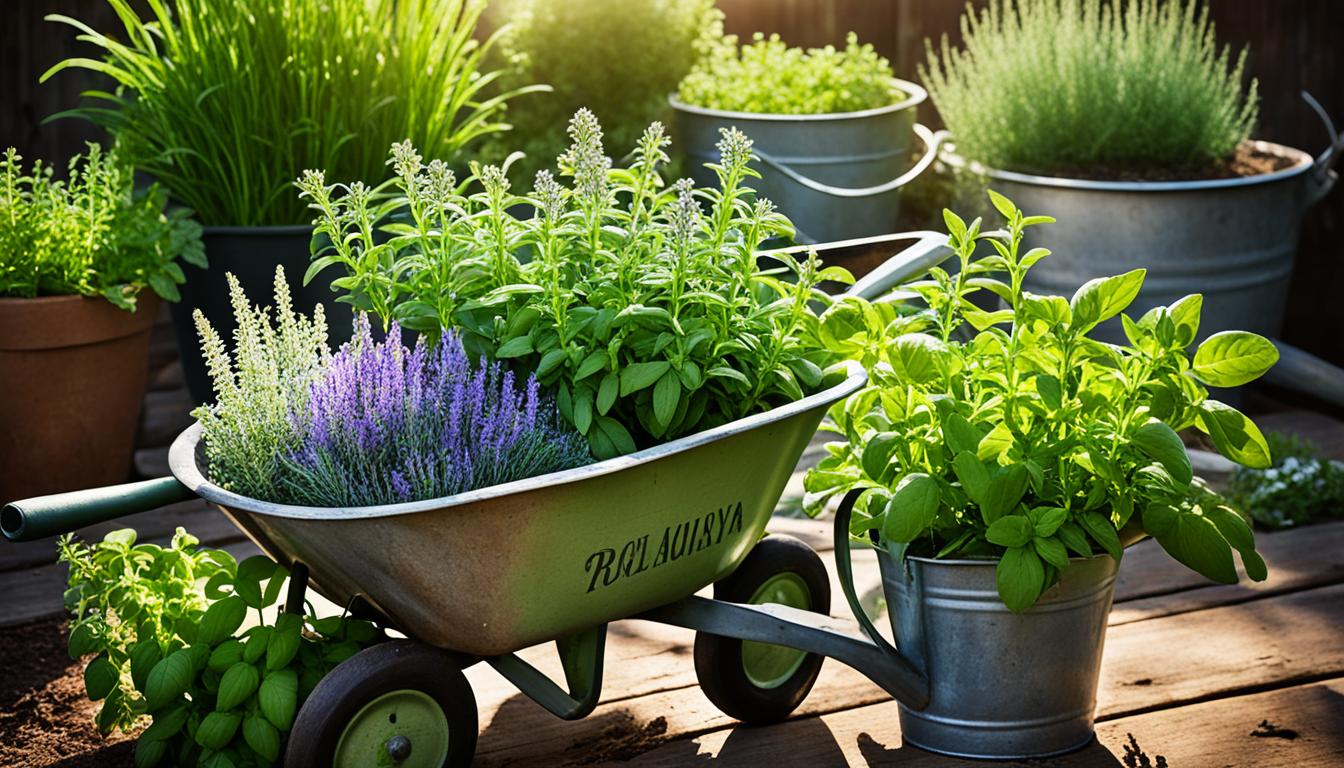
Imagine walking through your own lush, fragrant herb garden. You can pick fresh basil, rosemary, or thyme for your cooking. Growing your own Herb Gardens at home is rewarding and can change how you cook and connect with your food. This guide will help you create a thriving Herb Garden, even with a small space. You’ll learn how to pick the best herbs, plant, care for, and harvest them. This will make your cooking better and more enjoyable.
Key Takeaways
- Discover the joy and benefits of growing your own Herb Gardens at home
- Learn how to plan and design your perfect Herb Gardens, from container gardens to in-ground plots
- Explore a variety of popular Culinary Herbs and their diverse uses in the kitchen
- Uncover the essential tools and supplies needed to cultivate a thriving Herb Gardens
- Master the techniques for sowing, growing, and maintaining your Herb Gardens, indoors or outdoors
- Identify and address common Herb Gardens pests and problems
- Learn how to harvest and utilize your homegrown Herbs for maximum flavor and versatility
The Joy of Homegrown Herbs
Growing your own culinary herbs at home is very rewarding. You’ll always have fresh, flavorful herbs for your cooking. Just imagine picking fragrant basil, oregano, or thyme right from your garden for your meals.
Unleashing Flavors and Aromas in Your Kitchen
Homegrown herbs bring a unique taste that store-bought can’t match. Using herbs from your own garden makes meals more vibrant and exciting. It’s a way to make every dish special.
The Benefits of Growing Your Own Culinary Herbs
Homegrown herbs are good for your health too. They have natural remedies that boost your meals’ nutrition and support well-being. Adding these plants to your diet is a simple way to care for your health and spirit.
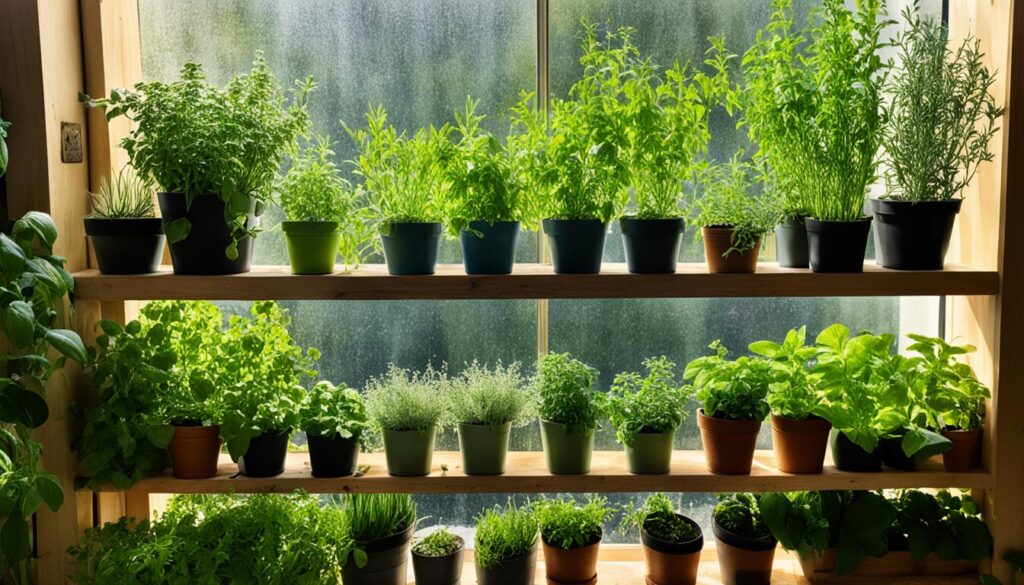
“Cooking with fresh, homegrown herbs is like unlocking a secret door to a world of vibrant flavors and aromas.”
Planning Your Herb Garden
Growing your own herb garden at home is fulfilling. It lets you enjoy fresh herbs right from your garden. Start by planning the layout and design carefully. Think about the space, sunlight, and what you like to grow.
You can grow herbs in containers, raised beds, or directly in the ground. The choice depends on your outdoor space and the herbs you want to grow. Containers are great for small spaces and can be moved around. Raised beds and in-ground plantings give more room for a variety of herbs.
Choosing which herbs to grow is important. Think about what you like to cook and which herbs will go well together. Also, consider how herbs can help each other grow. Some herbs do better when planted together, making your garden healthier and more productive.
- Assess the available space and sunlight exposure
- Decide on container, raised bed, or in-ground planting
- Choose the Herb Gardens that align with your cooking needs
- Explore Companion Planting techniques for a thriving Herb Garden
Plan your Herb Gardens well to make a space that looks good and works well. It will add flavor to your cooking and bring peace. Take time to plan, and you’ll enjoy fresh herbs from your garden.
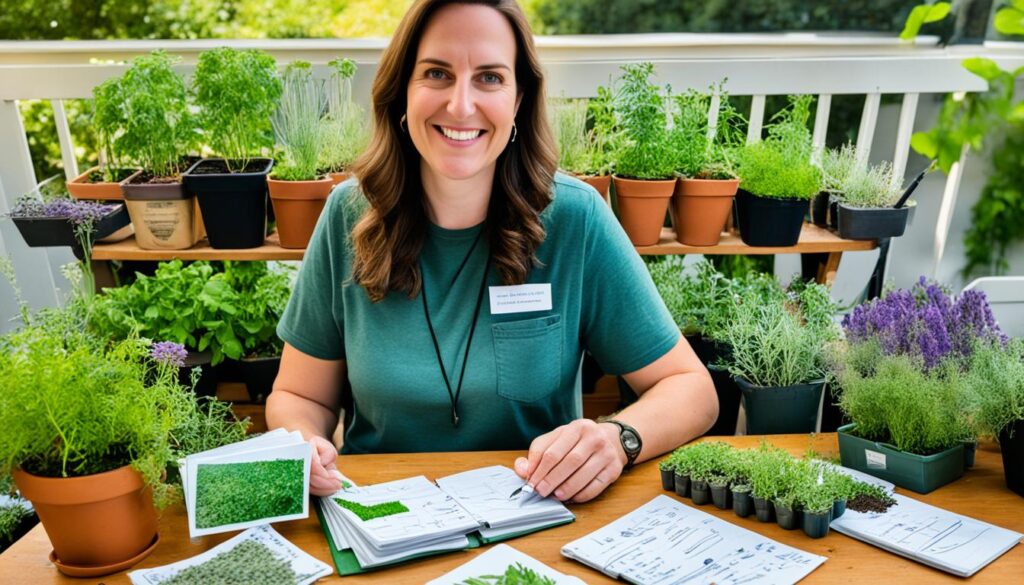
“The secret of success in life is to eat what you like and let the food fight it out inside.” – Mark Twain
Essential Herb Gardens Supplies
Starting an herb garden at home is exciting. But, you need the right tools and equipment for your edible plants to thrive. Whether you’re growing herbs indoors or outdoors, having the essentials is crucial for a good harvest.
Tools and Containers for a Thriving Herb Garden
To start your herb garden right, you’ll need these essentials:
- High-quality potting soil or seed starting mix
- A selection of herb seeds or seedlings
- Gardening pots, planters, or raised beds
- Pruning shears or scissors for harvesting
- A trowel for planting and transplanting
- A watering can or spray bottle
Choosing the right containers is important for your herbs. Think about drainage, sun exposure, and how big each plant will get. Pick pots or planters with good drainage holes to avoid waterlogging. Make sure the container is big enough for the mature size of each plant.
| Container Type | Best Herbs | Ideal Container Size |
|---|---|---|
| Window box | Basil, Chives, Oregano | 12-18 inches wide |
| Hanging basket | Thyme, Rosemary, Trailing Herbs | 12-14 inches diameter |
| Raised bed | Mint, Parsley, Sage | 8-12 inches deep |
With the right supplies and containers, you’ll be on your way to a thriving, flavorful herb garden at home.
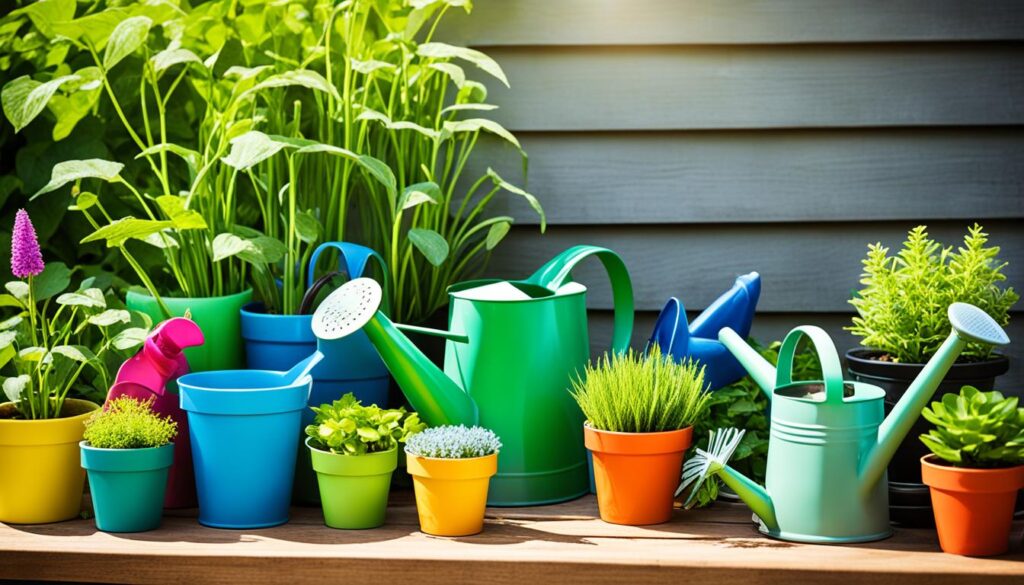
Choosing the Right Herbs
Starting a homegrown herb garden is exciting, especially picking which culinary herbs to grow. You can choose from classics like basil, thyme, and rosemary or try lemongrass and lavender for something different. Think about the flavors and scents you like and how you’ll use these homegrown herbs in your cooking.
Popular Culinary Herbs and Their Uses
Some herbs are key in the kitchen. Here are top picks and how they’re used:
- Basil: Adds a burst of flavor to Italian dishes, pesto, and homemade tomato sauces.
- Thyme: Earthy and versatile, it’s great with roasted meats, soups, and herbal remedies.
- Rosemary: Its pine-like scent makes it perfect for roasted veggies, potatoes, and grilled meats.
- Cilantro: Brings a bright, citrusy taste to Mexican and Asian dishes.
- Parsley: A staple that brightens sauces, salads, and many culinary dishes.
Growing your own herb garden means you always have fresh, flavorful herbs. This can make your kitchen garden and cooking better.
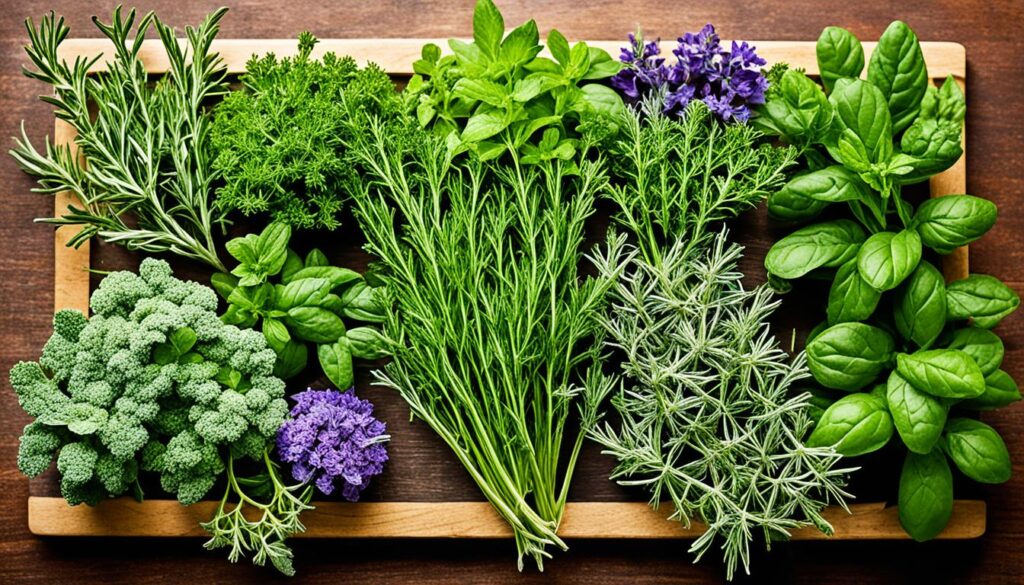
“Herbs are the friends of the physician and the pride of cooks.”
– Charlemagne
Herb Gardens: Sowing and Growing
Growing your own herb garden is a fulfilling journey. It’s more than just picking fresh, tasty ingredients. It’s about the excitement of sowing and growing your Herb Gardens.
First, think about what your herbs need. Some love the sun, while others do better in the shade. Make sure they have the right soil and space. Getting the seeds or seedlings right is key for a great Herb Gardens.
Companion Planting is a big part of the fun in Herb Gardens. By placing certain herbs with veggies and flowers, you help each other grow. This method keeps pests away and makes plants healthier. It also means you use fewer chemicals.
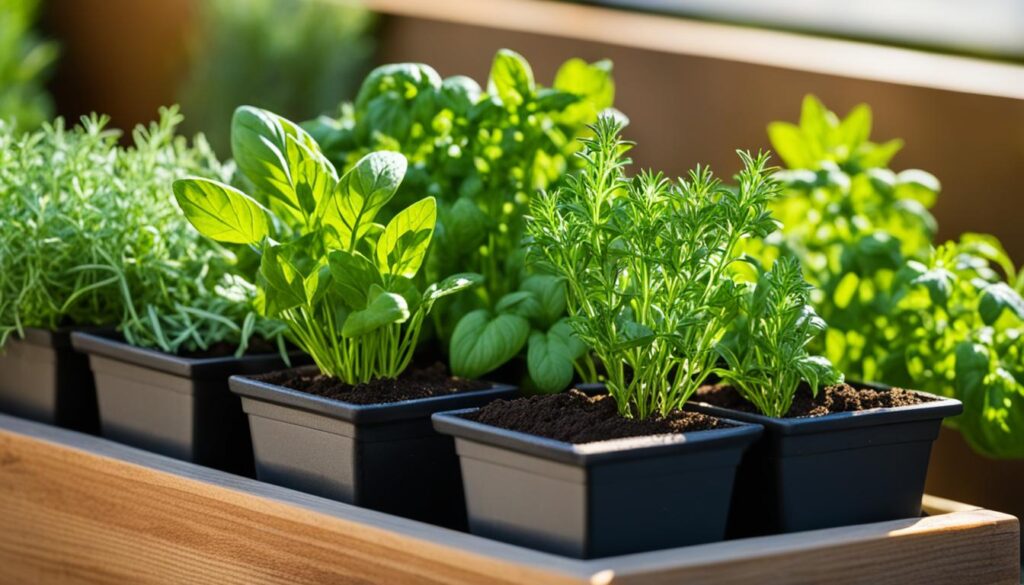
As your Herb Gardens grow, be patient and keep up with care. Water, weed, and prune regularly. Soon, you’ll enjoy the fresh tastes and smells of your Edible Plants.
| Herb | Sunlight Requirements | Soil Preferences | Companion Plants |
|---|---|---|---|
| Basil | Full sun | Well-drained, nutrient-rich | Tomatoes, peppers, asparagus |
| Rosemary | Full sun | Dry, well-drained | Cabbage, beans, carrots |
| Thyme | Full sun to partial shade | Dry, well-drained | Cabbage, strawberries, potatoes |
| Mint | Partial shade | Moist, well-drained | Tomatoes, cabbage, broccoli |
Follow these tips and use Companion Planting. You’ll create a thriving Herb Gardens. It will make your cooking better and your senses happier.
Caring for Your Indoor Herb Garden
Growing an indoor herb garden is rewarding. It lets you enjoy fresh herbs and aromatic plants all year. But, it needs a bit more care than an outdoor garden. Here are some tips to help your indoor herbs grow well.
Watering and Lighting
Watering your indoor herbs right is key. Keep the soil moist but not too wet. Check the soil every day and water when it feels dry on top. Your herbs also need enough light. Put them in a sunny spot near a window or use a grow light for good indoor light.
Maintenance Tips
Pruning and trimming are important for your indoor herbs. Cut off dead or damaged leaves and trim back the plants to keep them bushy and stop them from flowering. Also, turn your herb pots to make sure they get even light and don’t lean.
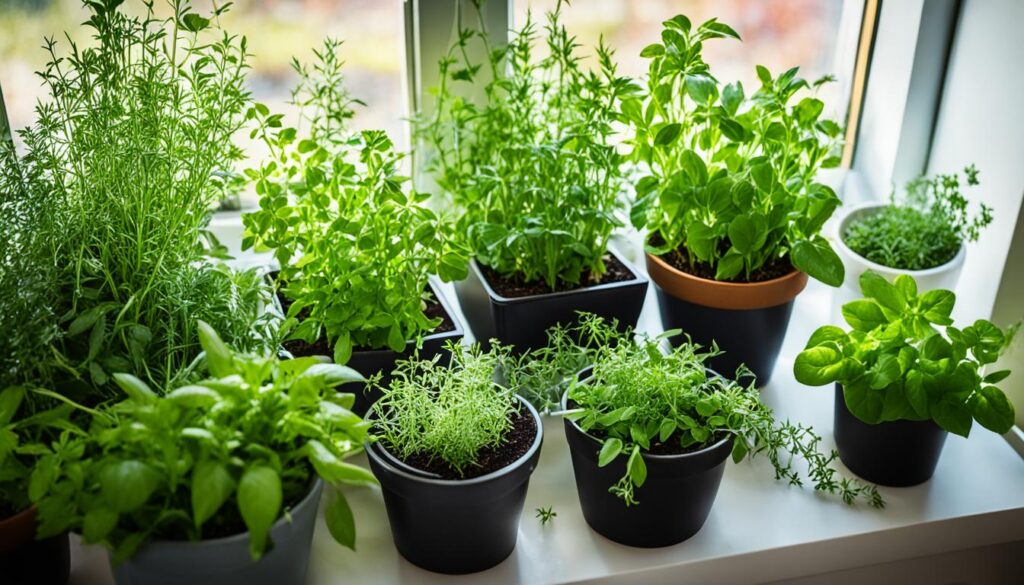
Follow these tips for watering, lighting, and maintenance. You’ll have a lush indoor herb garden. It will give you fresh, tasty herbs all year.
Herb Gardens Pests and Problems
Growing a thriving herb garden at home can be rewarding, but it comes with challenges. Even the best herb gardens can face pests or diseases. I’m here to help you spot common problems and find natural, organic fixes to fix them.
Identifying and Addressing Common Issues
From aphids to fungal infections, pests and problems can pop up in an Herb Garden. Let’s look at some common issues and how to handle them in an eco-friendly way:
- Aphids: These tiny insects can harm your Edible Plants. To get rid of them, spray your herbs with water and mild dish soap.
- Powdery Mildew: This disease makes herbs look like they’re covered in white powder. To fight it, improve air flow and use a baking soda solution.
- Companion Planting: Planting some herbs together can keep pests away. For example, basil near tomatoes can keep aphids and whiteflies away.
- Nutrient Deficiencies: If your herbs look dull, they might need more nutrients. Add organic compost or a balanced fertilizer to the soil.
| Common Herb Garden Pests | Organic Solutions |
|---|---|
| Aphids | Dish soap and water spray |
| Powdery Mildew | Baking soda solution |
| Whiteflies | Companion planting with basil |
| Nutrient Deficiencies | Organic compost or balanced fertilizer |
Stay alert and fix problems quickly to keep your Herb Gardens healthy and full of life. With some troubleshooting and organic remedies, you’ll enjoy a harvest of fresh, tasty herbs.

Harvesting and Using Your Homegrown Herbs
Growing your own Culinary Herbs is very rewarding. The real fun starts when you can use them in your cooking and Herbal Remedies. As a big fan of Kitchen Garden, I’m excited to share how to get the most from your Homegrown Herbs.
Harvesting herbs at the right time is key. The best time is usually in the morning, after the dew has gone and before the sun gets too hot. This makes sure the herbs have the strongest smell and taste.
- For leafy herbs like basil, mint, and parsley, just cut the leaves from the stems. Leave a bit of stem to help the plant grow back.
- For herbs like rosemary, thyme, and oregano, cut the stems close to the base of the plant with sharp scissors or pruners.
- For flowers like lavender and chamomile, cut them just before they open fully to get the best flavor.
After picking, you can use your Culinary Herbs right away or save them for later. You can dry, freeze, or infuse them in oil or vinegar to keep them fresh and flavorful all year.
| Herb | Culinary Uses | Herbal Remedies |
|---|---|---|
| Basil | Pesto, tomato dishes, salads | Anti-inflammatory, digestive aid |
| Rosemary | Roasted meats, potatoes, breads | Cognitive enhancement, immune booster |
| Lavender | Baked goods, beverages, garnishes | Stress relief, sleep aid |
Whether you’re making your favorite dishes or creating Herbal Remedies, your Homegrown Herbs are a real treasure. Enjoy the seasonal harvest and find new ways to use these tasty, fragrant plants in your life.
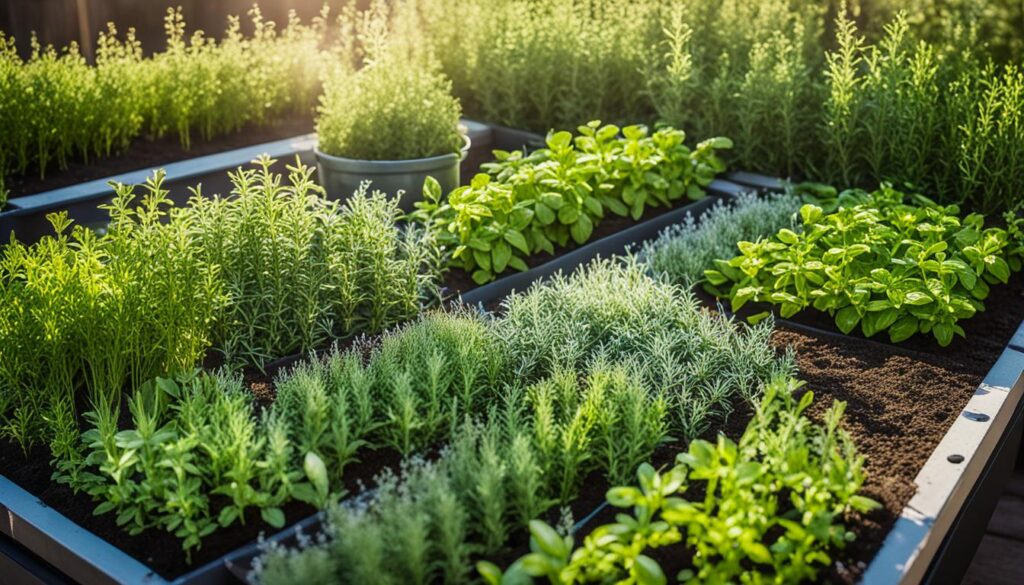
Conclusion
As we wrap up our exploration of Herb Gardens, I hope you’re ready to start your own. Growing Culinary Herbs at home is rewarding. It can make your cooking better, improve your health, and deepen your bond with nature.
Learning how to grow Herbs in your yard or an Indoor Garden opens up a new world. You’ll have access to fresh, tasty Edible Plants and fragrant Homegrown Herbs. These can change your Kitchen Garden and cooking for the better. You can try classic Herbal Remedies or new Companion Planting methods.
Enjoy the happiness of caring for your Herb Gardens. Your cooking and wellness will grow as you do. With the right knowledge and care, you’ll soon enjoy the special tastes and smells of Homegrown Herbs.



















Leave a comment